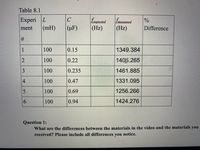
College Physics
11th Edition
ISBN: 9781305952300
Author: Raymond A. Serway, Chris Vuille
Publisher: Cengage Learning
expand_more
expand_more
format_list_bulleted
Question

Transcribed Image Text:Table 8.1
Experi L
(mH)
fespecied
(Hz)
fmcasured
(Hz)
C
ment
(µF)
Difference
#
1
100
0.15
1349.384
100
0.22
1405.265
3
100
0.235
1461.885
4
100
0.47
1331.095
100
0.69
1256.266
6.
100
0.94
1424.276
Question 1:
What are the differences between the materials in the video and the materials you
received? Please include all differences you notice.
2.

Transcribed Image Text:5. Calculate the expected resonant frequency using equation (1) for each circuit (all capacitances)
and enter the values in Table 8.1. Compare the measured and calculated resonant
frequencies and calculate the corresponding % differences using equation (2):
fmeasured-fexpected
% Difference =
100% (2)
fmeasured + fexpected
Expert Solution
This question has been solved!
Explore an expertly crafted, step-by-step solution for a thorough understanding of key concepts.
Step by stepSolved in 2 steps

Knowledge Booster
Learn more about
Need a deep-dive on the concept behind this application? Look no further. Learn more about this topic, physics and related others by exploring similar questions and additional content below.Similar questions
- you have a series RLC cir cuit made witha Resistor R=43-0 r, indactor L=27:0 MH, and capacibor C= 16-0nF. The Circuit is ariven by an AC source with Vems = 15.0V at Frequency f=7-90 KHZ- what is the RMS Voltage Ni across the inductor ? what is the RMS voltage AVC across the capacitor? %3Darrow_forwardNeeds Complete typed solution with 100 % accuracy.arrow_forwardIn an RLC circuit a second capacitor is addedin series to the capacitor already present. (a) Does the resonancefrequency increase, decrease, or stay the same? (b) Choose the bestexplanation from among the following:I. The resonance frequency stays the same because it dependsonly on the resistance in the circuit.II. Adding a capacitor in series increases the equivalent capacitance, and this decreases the resonance frequency.III. Adding a capacitor in series decreases the equivalent capacitance, and this increases the resonance frequency.arrow_forward
- A series circuit contains a resistor, a capacitor, and an inductor, connected to an A voltage source. The component values are as follows C = 0.60 µF The capacitor has a maximum safe peak voltage of 350 V, If the voltage source drives ie circuit at the resonant frequency, what is its largest possible peak voltage output to hot damage the capacitor? Hint: consider the current and impedance at resonance. R = 2.5 N L = 15 mHarrow_forwardUse the info given in this figure for the series RLC circuit to determine the phase angle between the current and voltagearrow_forwardPlease help me with the following question and make sure it's 100 % accurate, thank you. A sinusoidal ac voltage source in a circuit produces a maximum voltage of 11.2 V and an rms current of 7.80 mA . For related problem-solving tips and strategies, you may want to view a Video Tutor Solution of Current in a personal computer. Part A. Find the voltage amplitude. Express your answer in volts. Part B. Find the current amplitude. Express your answer in milliamperes. Part C. Find the rms voltage of this source. Express your answer in volts.arrow_forward
arrow_back_ios
arrow_forward_ios
Recommended textbooks for you
 College PhysicsPhysicsISBN:9781305952300Author:Raymond A. Serway, Chris VuillePublisher:Cengage Learning
College PhysicsPhysicsISBN:9781305952300Author:Raymond A. Serway, Chris VuillePublisher:Cengage Learning University Physics (14th Edition)PhysicsISBN:9780133969290Author:Hugh D. Young, Roger A. FreedmanPublisher:PEARSON
University Physics (14th Edition)PhysicsISBN:9780133969290Author:Hugh D. Young, Roger A. FreedmanPublisher:PEARSON Introduction To Quantum MechanicsPhysicsISBN:9781107189638Author:Griffiths, David J., Schroeter, Darrell F.Publisher:Cambridge University Press
Introduction To Quantum MechanicsPhysicsISBN:9781107189638Author:Griffiths, David J., Schroeter, Darrell F.Publisher:Cambridge University Press Physics for Scientists and EngineersPhysicsISBN:9781337553278Author:Raymond A. Serway, John W. JewettPublisher:Cengage Learning
Physics for Scientists and EngineersPhysicsISBN:9781337553278Author:Raymond A. Serway, John W. JewettPublisher:Cengage Learning Lecture- Tutorials for Introductory AstronomyPhysicsISBN:9780321820464Author:Edward E. Prather, Tim P. Slater, Jeff P. Adams, Gina BrissendenPublisher:Addison-Wesley
Lecture- Tutorials for Introductory AstronomyPhysicsISBN:9780321820464Author:Edward E. Prather, Tim P. Slater, Jeff P. Adams, Gina BrissendenPublisher:Addison-Wesley College Physics: A Strategic Approach (4th Editio...PhysicsISBN:9780134609034Author:Randall D. Knight (Professor Emeritus), Brian Jones, Stuart FieldPublisher:PEARSON
College Physics: A Strategic Approach (4th Editio...PhysicsISBN:9780134609034Author:Randall D. Knight (Professor Emeritus), Brian Jones, Stuart FieldPublisher:PEARSON

College Physics
Physics
ISBN:9781305952300
Author:Raymond A. Serway, Chris Vuille
Publisher:Cengage Learning

University Physics (14th Edition)
Physics
ISBN:9780133969290
Author:Hugh D. Young, Roger A. Freedman
Publisher:PEARSON

Introduction To Quantum Mechanics
Physics
ISBN:9781107189638
Author:Griffiths, David J., Schroeter, Darrell F.
Publisher:Cambridge University Press

Physics for Scientists and Engineers
Physics
ISBN:9781337553278
Author:Raymond A. Serway, John W. Jewett
Publisher:Cengage Learning

Lecture- Tutorials for Introductory Astronomy
Physics
ISBN:9780321820464
Author:Edward E. Prather, Tim P. Slater, Jeff P. Adams, Gina Brissenden
Publisher:Addison-Wesley

College Physics: A Strategic Approach (4th Editio...
Physics
ISBN:9780134609034
Author:Randall D. Knight (Professor Emeritus), Brian Jones, Stuart Field
Publisher:PEARSON